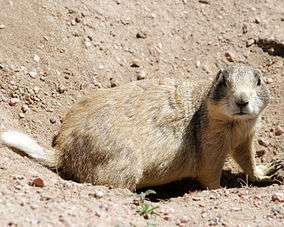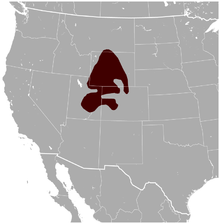White-tailed prairie dog
The white-tailed prairie dog (Cynomys leucurus) is found in western Wyoming and western Colorado with small areas in eastern Utah and southern Montana. The largest populations are in Wyoming where they are known colloquially as "chiselers".[3] This prairie dog species lives at an elevation between 5,000 and 10,000 feet, generally a higher elevation than other prairie dog species. Its predators include black-footed ferrets, badgers, and golden eagles.
| White-tailed prairie dog | |
|---|---|
 | |
| Scientific classification | |
| Kingdom: | Animalia |
| Phylum: | Chordata |
| Class: | Mammalia |
| Order: | Rodentia |
| Family: | Sciuridae |
| Genus: | Cynomys |
| Species: | C. leucurus |
| Binomial name | |
| Cynomys leucurus (Merriam, 1890) | |
 | |
| White-tailed Prairie Dog range[2] | |
Description
The white-tailed prairie dog is tan-brown in color, with large eyes and a dark patch on their cheeks above and below each eye.[4]
Behavior
White-tailed prairie dogs display Interspecific competition with the Wyoming ground squirrel. When the squirrel enters the territory of the prairie dog, the white-tailed prairie dog chases the squirrel. Rarely does the prairie dog capture and kill the squirrel, but when it does, it leaves the squirrel for avian predators, as the prairie dog is an herbivore. Female white-tailed prairie dogs who killed squirrels had increased litter sizes, but the higher her body count, the lower her chances of surviving each subsequent attack.[5]
Conservation status
White-tailed prairie dog populations have decreased dramatically, and the remaining population occupies only around 8% of their original range. It is threatened by human persecution (shooting and poisoning), and a disease called Sylvatic Plague that can infect all prairie dogs. This animal lives in small communities that are vulnerable to being wiped out by all of these issues. This species appears in the IUCN Red List of Threatened Species, with a status of least concern, last assessed in 1996.[1] Petitions have been made to protect the white-tailed prairie dog, but they have been denied by the United States Fish and Wildlife Service due to insufficient scientific data describing current population trends.[6] This denial is being reconsidered, because former deputy assistant secretary Julie MacDonald has been found to have improperly influenced the scientific basis of the denial. Groups such as the Biodiversity Conservation Alliance are working to legally protect this species.[7]
References
- Linzey AV, Hammerson G (2008). "Cynomys leucurus". IUCN Red List of Threatened Species. 2008. Retrieved 6 January 2009.CS1 maint: ref=harv (link)
- "Cynomys leucurus". IUCN 2014. The IUCN Red List of Threatened Species Version 2014.3. IUCN (International Union for Conservation of Nature). 2008. Retrieved 5 February 2015.
- Blevins W (2001). Dictionary of the American West. Sasquatch Books. p. 82. ISBN 1-57061-304-4.
- "White-tailed prairie dog". US Fish and Wildlife Service. Archived from the original on 2006-09-26.
- Hoogland JL, Brown CR (March 2016). "Prairie dogs increase fitness by killing interspecific competitors". Proceedings. Biological Sciences. 283 (1827): 20160144. doi:10.1098/rspb.2016.0144. PMC 4822469. PMID 27009223.
- "White-tailed Prairie Dog Press Release". US Fish and Wildlife Service.
- Lewis P (2007-07-20). "Agency to review species decisions". Washington Post.
External links
| Wikimedia Commons has media related to Cynomys leucurus. |
- Prairie dogs videos (in English)
- Prairie Dogs-Biodiversity Conservation Alliance
